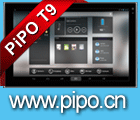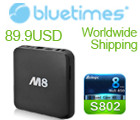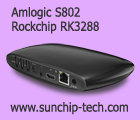Zaidtek E7 is an ARM11 Qualcomm MSM7227 based Android 2.1 capacitive tablet. You can notice that it looks similar to the Aigo N700 tablet that I posted earlier. This video also features the Zaidtek H7 Rockchip ARM9 RK2818 Android tablet. Prices are $350 and $250 respectively both including the built-in 3G modem for bulk orders of at least 200 pieces.
PocketBook 603, 903 and IQ at CES 2011
PocketBook are releasing the 603 Pro, 903 Pro and PocketBook IQ Android Tablet/E-reader globally.
Related articles
- PocketBook USA’s lineup announced (teleread.com)

USB3 SuperSpeed at up to 5Gbps
Today there are 165 certified USB SuperSpeed products, and a lot of products that haven’t yet been certified. Here’s an interview with a representative of the USB Implementers Forum about what it means for devices to get a USB SuperSpeed certification.
Related articles
- CES: USB 3.0 facing slow take-up from manufacturers (v3.co.uk)
- Is it worth waiting for USB 3.0? | Ask Jack (guardian.co.uk)
- Data Robotics SuperSpeeds storage appliance (go.theregister.com)

Seagate presents GoFlex hard drive with USM (Universal Storage Module) connector
The Sata-IO committee launched the new Universal Storage Module open standard at CES 2011, it’s a standardized Sata connector slow for devices like desktops, even laptops, media players and TVs to allow for full speed data transfers and one standard for the shape of 2.5″ removable hard drives. This GoFlex design from Seagate allows support for USB 2, USB 3, Firewire and any future connector that might come out, yet maxing out data transfer speed at the speed of Sata and of the spinning hard drive that comes inside. This video also features some description of Seagate’s Mementus XT hybrid hard drive product that speeds up OSes that can benefit from faster Flash based load times in combination with cheaper larger hard drive storage.
Related articles
- Seagate debuts new GoFlex drives, compatibility program (electronista.com)
- Seagate Unveils GoFlex Partner Program, USM Compatibility (pcworld.com)
- Seagate reveals 9mm 2.5-inch GoFlex external HDD, third-party GoFlex certification process (engadget.com)

Kodak Playfull, PlaySport and PlayTouch
Kodak releases a new bunch of compact pocket video cameras, including the very compact Kodak Playfull targetted at women that go clubbing, Kodak PlaySport Zx5 which is waterproof and shock proof, and the PlayTouch which has a 3″ touch screen and external microphone input.
Related articles
- Kodak PlaySport 2 Video Camera Hands-On (slashgear.com)
- New From Kodak: PlayFull Pocket HD Video Camera. Let’s Get Small! (offonatangent.blogspot.com)
- Kodak announces two new HD pocket video cameras (electronista.com)
- Kodak Playsport Pocket Cam Gets Ruggeder, and the Playfull Is Its Tiny 1080p Sibling [Pocketcams] (gizmodo.com)

Digilife DDV-J6, HD camcorder with built-in LCOS qvga projector
This is a pocket HD camcorder with a built-in qvga projector, it’s on the market for about $299. Find more informations here.
Acer Iconia Tab A500, Tegra2 Android Tablet
Acer is also one of the major companies launching Tegra2 ARM Cortex-A9 powered Android Tablets. This one seems to have a 1280×800 10.1″ capacitive touch screen, 1GB RAM, 2mpixel front and 5mpixel back cameras, 4G LTE compatible and should be upgraded to Honeycomb when it releases in the next few months.
Related articles
- Acer ICONIA Tab A500 for Verizon Will Support 4G LTE (slashgear.com)
- Acer Reveals Iconia Tab A500 Tablet for Gamers (mwd.com)
- Acer Iconia Tab A500 Comes with LTE Capabilities (Video) (devicemag.com)
- Acer announces Iconia Tab A500 10-inch Android tablet with LTE (engadget.com)
- Acer Iconia Tab A500 confirmed as early Verizon 4G tablet (electronista.com)
- Acer Iconia Tab A500 first hands-on! (engadget.com)
- Acer Iconia Tab A500 Android tablet pleases with LTE and Tegra 2 (intomobile.com)

ViewSonic ViewPad 10s Tegra2 Android Tablet
Similar to the ViewSonic G-Tablet, this one is to be sold and supported by ViewSonic directly while the G-Tablet is supported by US merchants. I try to ask the ViewSonic representative what ViewSonic is doing to allow for alternative Android UI, firmware updates and more.
Related articles
- ViewSonic ViewPad 10S Tablet Unveiled (trustedreviews.com)
- ViewSonic ViewPad 10 and 10s hands-on (engadget.com)

MSI WindPad 100A prototype
MSI is nearing release of their Android tablet series, here is the WindPad 100A prototype. It’ll run the Nvidia Tegra2 processor and have MSI’s custom Android UI.
Related articles
- CES 2011: MSI WindPad 100A Tegra 2 Android Tablet Offers a Peek; Q2 Release Date Likely (devicemag.com)
- CES: MSI shows WinPad 100A (ces.cnet.com)
- MSI Shows Off Its Android-Powered WindPad 100A (androidpolice.com)

I filmed 106 videos at CES 2011
I have uploaded 66 of my CES 2011 videos here on ARMdevices.net thus far, and I still have about 40 videos to upload and publish during the next few days. Yup, I beat my previous record at CES 2010 where I only filmed 72 videos.
What do you think about the quality of those videos? I appreciate all comments.
I have now arrived back in Denmark Europe where I can now continue to upload and publish the remaining 40 CES videos during the next few days, and then I’ll post my top-10 CES gadget video lists. So please check back here for more CES videos to still be posted during the next few days.
This CES was absolutely awesome for ARM fans, we saw the first new ARM Powered dual-core super phones, we saw Microsoft announce ARM support, Blackberry bringing their cool new tablet OS on an extremely powerful OMAP4430 dual-core processor, Sony-Ericsson, LG, Huawei bringing great new Android super phones, Acer, LG, Panasonic, Sharp, Vizio all joining the Android tablet party, we saw many new interesting tablets from many manufacturers and even cool new ARM Powered Laptops and Set-top-boxes. Check back for more.
Aigo N700, 7″ capacitive Android Tablet with built-in 3G
Aigo is a Chinese company who has been making portable media players for a while and now they are doing this capacitive 7″ Android tablet, it’s powered by Qualcomm MSM7227 ARM11 processor, comes with built-in 3G CDMA modem for around $450 unlocked retail price. So it is cheaper than the Samsung Galaxy Tab, but it’s also using a cheaper 600mhz ARM11 processor.
Robo Builder at CES 2011
Robo Builder is selling this Robot building kit for around $840 which allows the user to build a robot in any of 4 or more configurations, as normal robot, spider, dog or car configurations, and then program it’s movements and it has some sensors too. It takes in average 1 hour to build it for the consumer.
Huawei Ideos X5 Android Phone
Huawei’s new 3.8″ capacitive Android smart phone.
Related articles
- Huawei IDEOS X5 Available In SE Asia This Month, US This Summer (pocketnow.com)
- CES: Huawei Ideos X5 First Look (video) (ces.cnet.com)
- Huawei IDEOS X5 hands-on (engadget.com)
- Huawei’s Ideos X5 Smartphone Plays 720p Video (pcworld.com)

NEC LT-W Android Dual-Screen Tablet
Comes with two 7 inch resistive screens, to use with finger or stylus (productivity), 530 grams, it runs an ARM Cortex-A8 processor, 384MB RAM, USB host, SD card slot and more. The concept is pretty awesome.
Related articles
- NEC LT-W Cloud Communicator dual-screen Android tablet detailed (slashgear.com)
- NEC Shows Dual-screen Android PC (pcworld.com)
- NEC gets official with dual-screen 7-inch LT-W Cloud Communicator (engadget.com)
- CES: NEC dual-screen tab great for packed trains (ces.cnet.com)
- CES 2011: NEC’s Android Tablet Twist Is Dual-Screen (informationweek.com)

Huawei U9000 4.1″ Android Phone
Huawei is showing this 4.1″ capacitive high-end Android phone.
Related articles
- Huawei Ideos X5 and U9000 Hands On (Video) (pocketnow.com)
- Hands on with Huawei Ideos X5 and U9000 Android phones (electronista.com)

Mastone 10.1″ OMAP3630 Android Tablet
This is a 10.1″ tablet by Mastone powered by the Texas Instruments OMAP3630 ARM Cortex-A8 1Ghz processor.
Hanvon E920, 9.7″ color e-ink e-reader prototype
Supports both capacitive touch and Hanvon’s pen input.
Related articles
- Hanvon E920 Color E-Ink Reader Shown Off at CES (devicemag.com)
- Hanvon brings E920, world’s first color E Ink reader, to CES, we go hands-on (video) (engadget.com)
- Hanvon WISEreader E920 claims better readability (slashgear.com)
- Hanvon outs Wisereader E920 9.7in hi-res E Ink Reader (electronista.com)
- We go hands-on with Hanvon’s E920 color e-reader, tablets (electronista.com)
- Color E Ink To Be Sold In Hanvon E-Reader (huffingtonpost.com)
- Hanvon aims to be first to sell e-Reader with color e-Ink (gizmag.com)
- Hanvon to be first with color E Ink reader, sizes it at 10 inches, makes it a touchscreen (engadget.com)

OLPC XO-1.75, ARM Powered OLPC XO Laptop is faster than x86!
OLPC CTO Edward J. McNierney gives us an overview of the ARM Marvell Armada 610 version of OLPC XO Laptop, XO 1.75, to be released soon, being optimized now in Taiwan, it provides for a sub 2 Watt One Laptop Per Child XO Laptop. One Laptop Per Child created the Netbook market, now they will push the PC/Laptop industry towards ARM support for lower power consumption and lower prices through increased industry competition and optimized SoC designs. The $100 Laptop is nearer. Marvell’s 610 is now one of the ARM SoC platforms that is now powerful enough to power a full desktop/laptop system.
NEC Tegra2 Powered 7″ Laptop
Here’s an ARM Cortex-A9 7″ Laptop prototype shown by NEC here at CES it runs Android 2.2 and is about 600 grams.
Innodigital WebTube, Android ARM Cortex-A9 set-top-box
They are showing Samsung Hummingbird ARM Cortex-A8 model available now for $168 and showing their next generation running on ARM Cortex-A9 , they have a cool bunch of remote controls with Android buttons, shortcuts and even gyroscope based RF remote controller.



